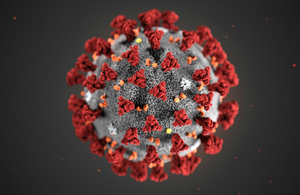January 2021 findings from COVID-19 study published
Initial findings from Imperial College London and Ipsos MORI show infections increased by 50% from early December, with 1 in 63 people infected.

- Over 142,900 volunteers were tested in England from 6 to 15 January 2021 as part of one of the most significant COVID-19 studies.
- It remains paramount everyone stays at home and follows the rules to protect the NHS and save lives.
The interim findings from the eighth report of REACT, one of the country’s largest studies into COVID-19 infections in England, have been published today by Imperial College London and Ipsos MORI.
Over 142,900 volunteers were tested in England from 6 to 15 January to examine the levels of infection in the general population. The findings show infections in England have plateaued at the highest level recorded by a REACT study, with suggestions of a potential uptick. The report does not yet reflect the impact of national lockdown.
Prevalence from 6 to 15 January was highest in London, with 1 in 36 people infected – more than double compared to the previous REACT report in early December. Infections had also more than doubled in the South East, East of England and West Midlands compared to the previous REACT report in early December.
The main findings from the eighth REACT study show:
- national prevalence increased by 50% from 0.91% in early December to 1.58%, or 158 per 10,000 infected
- national R was estimated at 1.04
- regional prevalence was highest in London where it had more than doubled from 1.21% to 2.8%. It had also more than doubled in the South East (0.75% to 1.68%); East of England (0.59% to 1.74%); and West Midlands (0.71% to 1.76%). It increased in the South West (0.53% to 0.94%) and North West (0.92% to 1.41%). There was a decrease in Yorkshire and The Humber (1.39% to 0.84%). It was stable in the East Midlands (1.04% to 1.16%) and North East (1.26% to 1.18%)
- prevalence increased nationally in all adult age groups and was highest in 18 to 24 year olds at 2.51%. Prevalence in the over 65s more than doubled from 0.41% to 0.94%
- large household size, living in a deprived neighbourhood, and areas with higher numbers of black and Asian ethnicity individuals were associated with increased prevalence; healthcare and care home workers, and other key workers, were more likely to test positive compared to other workers
- the report contains mobility data for the first time showing peoples’ movement decreased at the end of December and increased at the start of January and helps explain change in prevalence
While prevalence has decreased in Yorkshire and the Humber and has remained stable across the East Midlands and North East, infection numbers remain high in all of these regions.
The figures demonstrate everyone must stay at home to reduce infections, protect the NHS and save lives.
Health Secretary Matt Hancock said:
These findings show why we must not let down our guard over the weeks to come.
Infections across England are at very high levels and this will have a knock-on effect on the already significant pressures faced by our NHS and hospitals.
It is absolutely paramount that everyone plays their part to bring down infections. This means staying at home and only going out where absolutely necessary, reducing contact with others and maintaining social distancing.
Professor Paul Elliott, director of the programme at Imperial, said:
Our data are showing worrying suggestions of a recent uptick in infections which we will continue to monitor closely.
To prevent our already stretched health system from becoming overwhelmed infections must be brought down; if prevalence continues at the high rate we are seeing then hospitals will continue to be put under immense pressure, and more and more lives will be lost. We all have a part to play in preventing this situation from worsening and must do our best to stay at home wherever possible.
There has been increasing pressure on the NHS with 15,000 people admitted to hospitals since Christmas Eve – over 20 hospitals’ worth of new patients. While the vaccine programme continues to accelerate and expand to protect as many people as possible, with over 4 million people vaccinated, we do not know whether being vaccinated stops someone from passing the virus on to others. It will also be some time before the impact of the vaccination programme reduces pressures on hospitals.
It is critical everyone continues to follow the rules, stays at home, reduces contact with others and maintains social distancing – remembering hands, face, space.
Kelly Beaver, Managing Director of Public Affairs at Ipsos MORI said:
As we reach a milestone of over a million people in England having COVID-19 at any one time of our study, the real time tracking of COVID-19 across England is more important than ever. Our study’s ability to find individuals who have the virus, but do not display symptoms, is due to the millions of members of the public that have taken part, who I would like to thank for volunteering, helping to provide the Government with an invaluable tool as we fight this pandemic.
This report is the latest from the REACT study which was commissioned by DHSC and carried out by a world-class team of scientists, clinicians and researchers at Imperial College London, Imperial College Healthcare NHS Trust and Ipsos MORI.
Background information
Read more information on the Real-time Assessment of Community Transmission (REACT) programme of work
This study falls under Pillar 4 of the COVID-19 National Testing Programme, which focuses on mass surveillance in the general population.